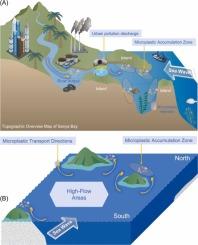河口塑性动力学:亚洲典型半封闭海湾出口模式分析
IF 11.3
1区 环境科学与生态学
Q1 ENGINEERING, ENVIRONMENTAL
引用次数: 0
摘要
半封闭的河口系统被认为是微塑料(MP)污染的热点,但其出口动态仍然知之甚少。本文研究了三亚湾中微塑料(>5 mm)和巨塑料(>5 mm)的分布。45个地表水样品的MP浓度范围为0.298 ~ 4.010个/m³(平均值:1.628±1.055),显著高于宏观塑料(平均值:0.109±0.338)。大多数颗粒为小于5mm的碎片,以白色、绿色和透明色为主。鉴定的主要聚合物是聚丙烯(PP)、聚乙烯(PE)和聚对苯二甲酸乙二醇酯(PET)。观察到一种“双中心”模式:低密度塑料(如PP、PE)积聚在河口和近海岛屿附近,而高密度塑料(如PET、PVC)积聚在河口地带。主坐标分析(PCoA)揭示了受陆地输入、人类活动和水动力运输影响的河口、沿海和近海区域的空间聚类。这项研究为半封闭海湾中的塑料运输机制提供了新的见解,并强调了将塑料特性与环境力相结合的重要性。研究结果支持在类似的沿海环境中进行有针对性的污染管理。本文章由计算机程序翻译,如有差异,请以英文原文为准。

Estuarine Plastic Dynamics: Analyzing Export Patterns from a Typical Semi-Enclosed Bay in Asia
Semi-enclosed estuarine systems are recognized as hotspots for microplastic (MP) pollution, yet their export dynamics remain poorly understood. This study investigates the distribution of microplastics (<5 mm) and macroplastics (>5 mm) in Sanya Bay, a typical semi-enclosed bay in southern China. Based on 45 surface water samples, MP concentrations ranged from 0.298 to 4.010 items/m³ (mean: 1.628 ± 1.055), significantly higher than macroplastics (mean: 0.109 ± 0.338 items/m³). Most particles were fragments smaller than 5 mm, dominated by white, green, and transparent colors. The main polymers identified were polypropylene (PP), polyethylene (PE), and polyethylene terephthalate (PET). A “dual-center” pattern was observed: low-density plastics (e.g., PP, PE) accumulated near river mouths and offshore islands, while high-density plastics (e.g., PET, PVC) settled in estuarine zones. Principal Coordinate Analysis (PCoA) revealed spatial clustering across estuarine, coastal, and offshore areas, influenced by land-based inputs, human activity, and hydrodynamic transport. This study provides new insights into plastic transport mechanisms in semi-enclosed bays and highlights the importance of integrating plastic properties with environmental forces. The findings support targeted pollution management in similar coastal environments.
求助全文
通过发布文献求助,成功后即可免费获取论文全文。
去求助
来源期刊

Journal of Hazardous Materials
工程技术-工程:环境
CiteScore
25.40
自引率
5.90%
发文量
3059
审稿时长
58 days
期刊介绍:
The Journal of Hazardous Materials serves as a global platform for promoting cutting-edge research in the field of Environmental Science and Engineering. Our publication features a wide range of articles, including full-length research papers, review articles, and perspectives, with the aim of enhancing our understanding of the dangers and risks associated with various materials concerning public health and the environment. It is important to note that the term "environmental contaminants" refers specifically to substances that pose hazardous effects through contamination, while excluding those that do not have such impacts on the environment or human health. Moreover, we emphasize the distinction between wastes and hazardous materials in order to provide further clarity on the scope of the journal. We have a keen interest in exploring specific compounds and microbial agents that have adverse effects on the environment.
 求助内容:
求助内容: 应助结果提醒方式:
应助结果提醒方式:


